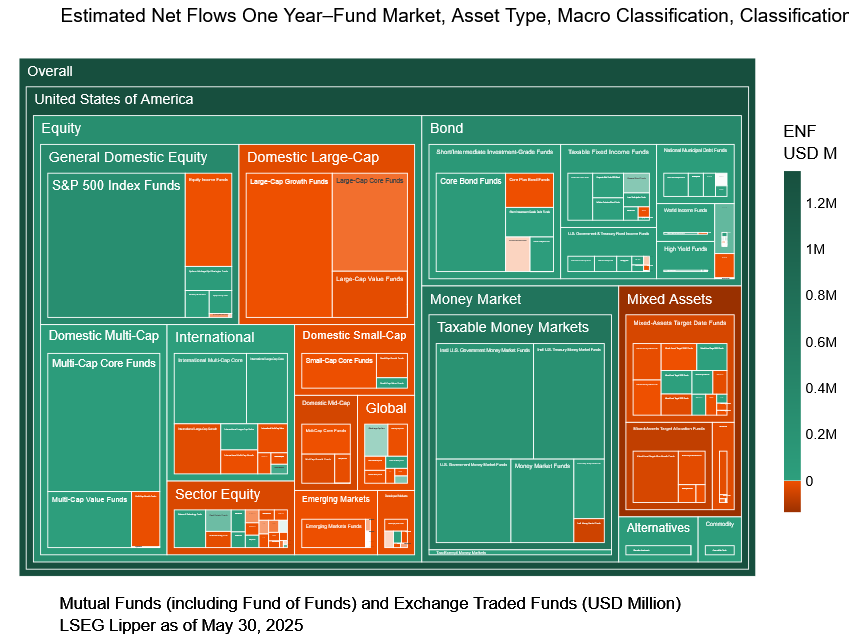Total assets under management in the US fund market fell $102.0 billion (-0.3%) for May and stood at $39,362.3 billion at the end of the month. Estimated net outflows accounted for $128.7 billion, while $26.7 billion was added because of the positively performing markets. On a year-to-date basis, assets decreased $1,206.0 billion (-3.0%). Included in the overall year-to-date asset change figure were $288.7 billion of estimated net inflows.
Compared to a year ago, assets increased exceptionally $3,993.3 billion (+11.3%). Included in the overall one-year asset change figure were $1,339.7 billion of estimated net inflows. The average overall return in US dollar terms was a negative 0.1% at the end of the reporting month, underperforming the 12-month moving average return by 0.7 percentage points and underperforming the 36-month moving average return by 0.6 percentage points.
Fund Market by Asset Type, May
Most of the net new money for May was attracted by equity funds, accounting for $8,819.7 million, followed by alternatives funds and commodity funds, at $6,590.2 million and $4,504.0 million of net inflows, respectively. Money Market funds, at negative $85,304.7 million, were at the bottom of the table for May, bettered by bond funds and mixed assets funds, at $51,909.2 million and $11,373.9 million of net outflows, respectively.
The best performing funds for the month were money market funds at 0.3%, followed by mixed assets funds and equity funds, at 0.1% and 0.0% returns, respectively, on average. Commodity funds, at negative 3.9%, were the worst performers for the month, bettered by alternatives funds and bond funds, at negative 1.3% and positive 0.0%, respectively.
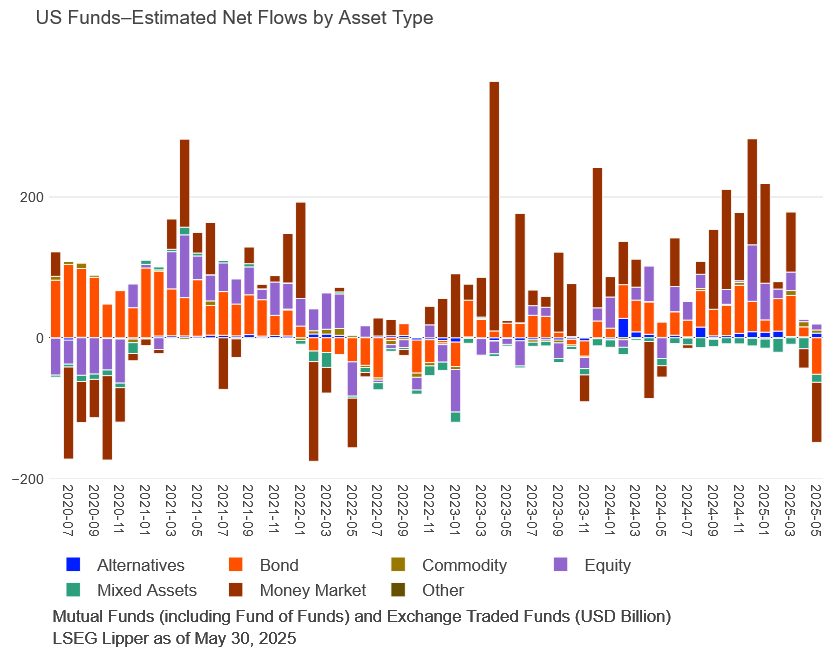
Fund Market by Asset Type, Year to Date
For the year to date, most of the net new money was attracted by money market funds, accounting for $125,298.1 million, followed by equity funds and bond funds, at $104,565.5 million and $84,231.6 million of net inflows, respectively. Mixed Assets funds, at negative $68,738.1 million, were at the bottom of the table for the year to date, bettered by other funds and commodity funds, at $0.0 million and $16,061.7 million of net inflows, respectively.
The best performing funds for the year to date were commodity funds at 3.0%, followed by money market funds and bond funds, at 1.6% and 0.4% returns, respectively, on average. Equity funds, at negative 6.3%, were the worst performers, bettered by mixed assets funds and alternatives funds, at negative 2.7% and negative 0.8%, respectively.
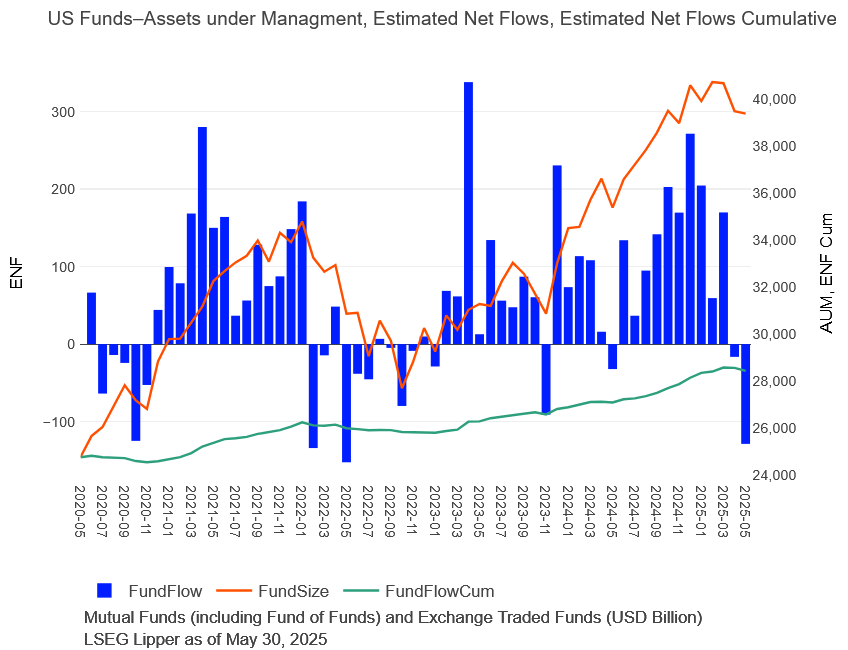
Fund Market by Asset Type, Last Year
Most of the net new money for the one-year period was attracted by money market funds, accounting for $712,838.2 million, followed by bond funds and equity funds, at $385,539.0 million and $289,926.0 million of net inflows, respectively. Mixed Assets funds, at negative $138,982.0 million, were at the bottom of the table for the one-year period, bettered by other funds and commodity funds, at $0.0 million and $22,011.4 million of net inflows, respectively.
The best performing funds for the one-year period were mixed assets funds at 8.7%, followed by equity funds and bond funds, at 8.2% and 5.9% returns, respectively, on average. Alternatives funds, at negative 0.1%, were the worst performers, bettered by commodity funds and money market funds, at positive 2.9% and positive 4.3%, respectively.
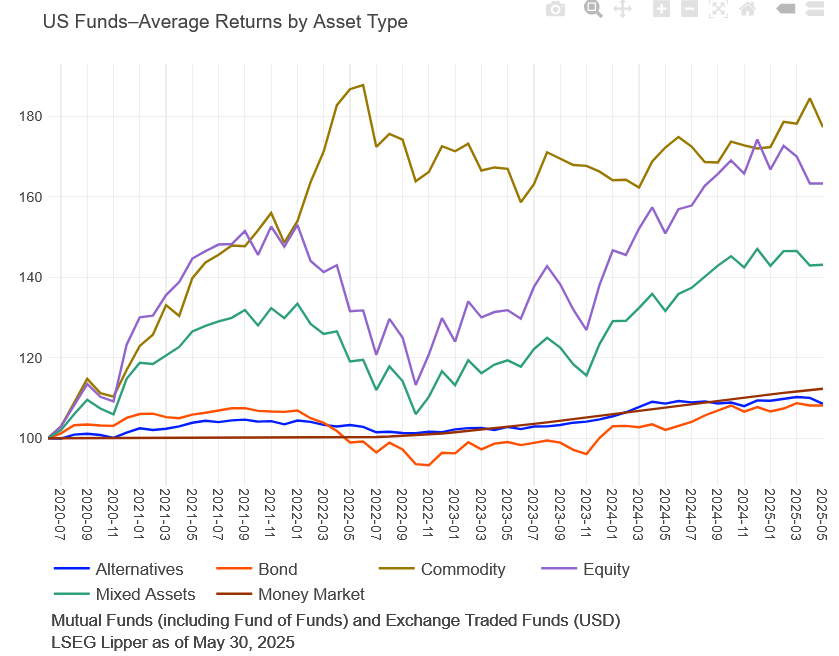
Lipper US Classifications, May
Looking at Lipper’s fund classifications for May, most of the net new money flows went into Multi-Cap Core Funds (+$27,363.7 million), followed by Short U.S. Treasury Funds and Funds (+$18,946.4 million and +$12,839.3 million). The largest net outflows took place for Instl U.S. Government Money Market Funds, at negative $39,388.6 million, bettered by Core Bond Funds and Instl U.S. Treasury Money Market Funds, at negative $27,879.4 million and negative $20,858.2 million of net outflows, respectively.
The best performing funds for the month were International Real Estate Funds, at plus 7.0%, followed by Precious Metals Equity Funds and Latin American Funds, at plus 7.0% and plus 6.8% returns, respectively, on average. Commodities Energy Funds, at minus 12.0%, was the worst performer, bettered by Natural Resources Funds and Commodities Base Metals Funds funds, at minus 11.4% and minus 9.1%, respectively.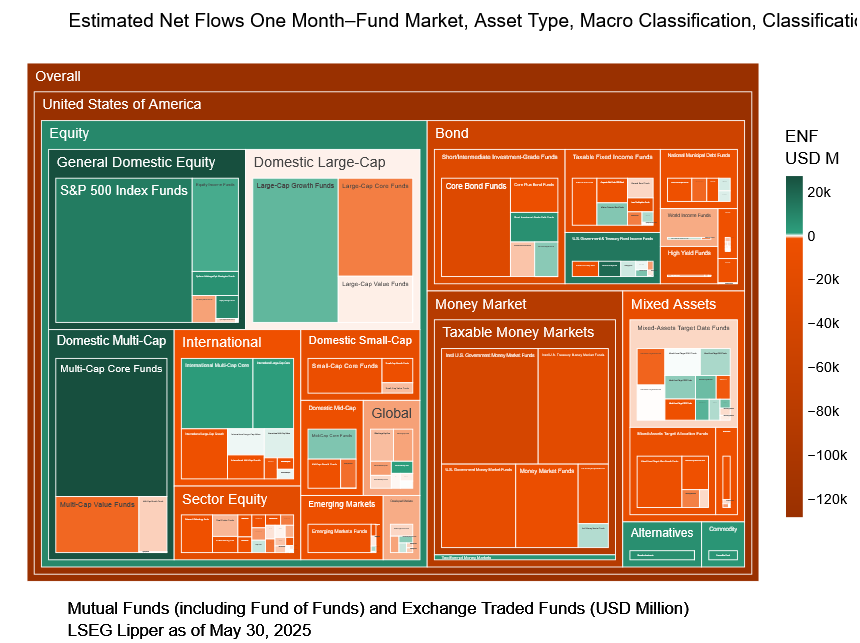
Lipper US Classifications, Year to Date
For the year to date, most of the net new money flows went into S&P 500 Index Funds (+$109,233.9 million), followed by Multi-Cap Core Funds and Money Market Funds (+$62,609.0 million and +$60,104.9 million). The largest net outflows took place for Instl U.S. Government Money Market Funds, at negative $37,510.7 million, bettered by Mixed-Asset Target Alloc Growth Funds and Small-Cap Core Funds, at negative $21,569.9 million and negative $16,673.2 million of net outflows, respectively.
The best performing funds for the year to date were Precious Metals Equity Funds, at plus 28.0%, followed by Commodities Precious Metals Funds and Latin American Funds, at plus 15.9% and plus 13.8% returns, respectively, on average. Small-Cap Value Funds, at minus 18.4%, was the worst performer, bettered by Equity Leverage Funds and Small-Cap Growth Funds funds, at minus 17.9% and minus 17.7%, respectively.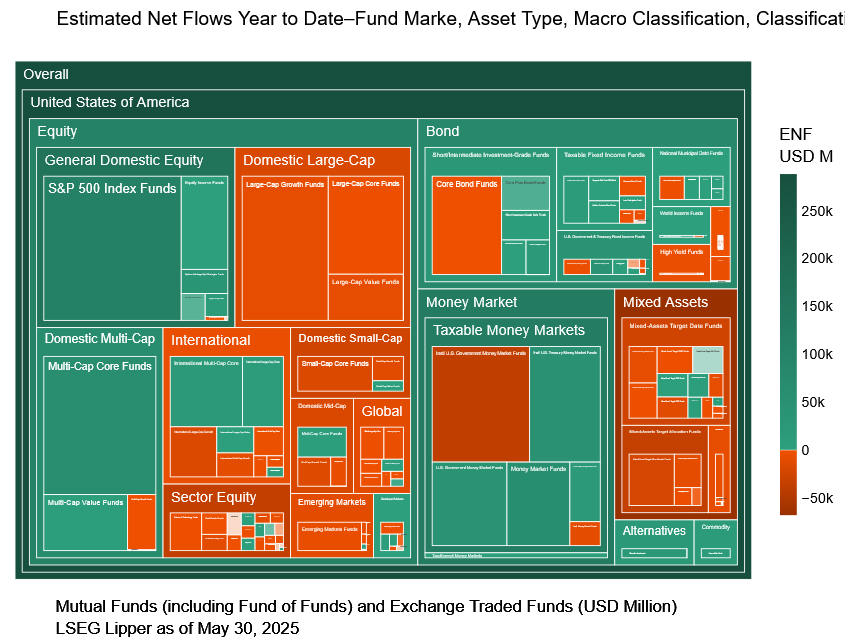
Lipper US Classifications, Last Year
For the one-year period, most of the net new money flows went into S&P 500 Index Funds (+$277,893.7 million), followed by Instl U.S. Treasury Money Market Funds and Instl U.S. Government Money Market Funds (+$235,252.4 million and +$208,148.7 million).
The largest net outflows took place for Instl Money Market Funds, at negative $56,412.4 million, bettered by Mixed-Asset Target Alloc Growth Funds and Mid-Cap Growth Funds, at negative $41,316.1 million and negative $30,076.1 million of net outflows, respectively.
The best performing funds for the one-year period were Precious Metals Equity Funds, at plus 47.7%, followed by Commodities Precious Metals Funds and Telecommunication Funds, at plus 29.9% and plus 26.0% returns, respectively, on average. Dedicated Short Bias Funds, at minus 23.5%, was the worst performer, bettered by Natural Resources Funds and Alternative Managed Futures Funds funds, at minus 13.3% and minus 12.2%, respectively.